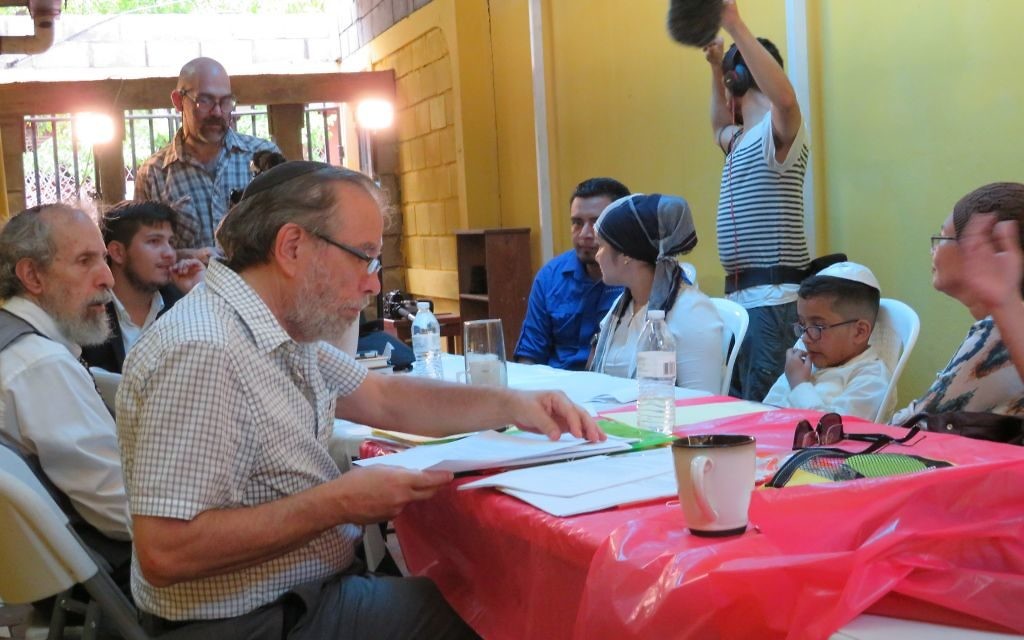Mission to Nicaragua Finds 114 New Jews
After 525 years of hiding under the Edict of Expulsion Jews in Nicaragua find solace in conversion.
My wife, Cheryl, and I went on a special mission to Nicaragua this summer, but it is impossible to explain the mission without a bit of history.
“In 1492 Columbus sailed the ocean blue.” That you know. Let me tell you, as Paul Harvey would put it, the rest of the story.
Columbus postponed his voyage a couple of days because he was supposed to set sail July 31, which was Tisha B’Av, the ninth day of the Jewish month of Av, which is the most tragic day in the Jewish calendar, a day on which all the great tragedies that ever happened to the Jewish people occurred.
Get The AJT Newsletter by email and never miss our top storiesFREE SIGN UP
Was Columbus Jewish? You bet he was, and there is a good deal of proof, but that’s a subject for another article.
It was on that Tisha B’Av in 1492 that Queen Isabella of Spain’s Edict of Expulsion of the Jews under the Inquisition took effect. It declared that all Jews who had not left Spain since the signing of the edict four months earlier had to convert or die. Then the government made it almost impossible for Jews to leave the country because it abducted the children of those who tried.
Even if one succeeded in leaving, where would one go? Few countries welcomed Jews, and it was a treacherous journey getting anywhere. Many fled to Portugal, but the Inquisition soon followed them there.
In the 16th and 17th centuries, some fled to the New World, to places like Bahia and Recife, Brazil, because it was controlled by the Dutch, who more or less welcomed Jews. But Portugal soon conquered Brazil, and the Jews had to flee again. Some wound up in New Amsterdam, which soon became New York, and others in the emerging communities of the Caribbean like Curacao, Suriname, Santo Domingo and Jamaica.
Many openly converted to Christianity but secretly remained Jews. The Christians called them Marranos (pigs). They had to be especially careful because if they were caught not burning their stoves on Saturday or not eating on Yom Kippur or doing a Jewish custom or not showing up for church on Sunday, the Inquisition would arrest them, torture them on racks that tore their bodies apart, force them to inform on other secret Jews, burn them at the auto-da-fé and take all their assets.

Can you imagine the terror this engendered? No wonder they were careful not to tell their children much about being Jewish, for fear it might spill out when they played with Christian children.
Now how long do you think being Jewish would have lasted for these Jews — one generation or two, 50 or 100 years? How about 525 years!
How amazing is the Jewish spirit, the Jewish soul? A full 525 years after the signing of the Edict of Expulsion, the Jewish soul emerges as strong as ever in Nicaragua, which in 2012 had only 50 Jews.
In mid-June I received a call from Kulanu (Hebrew for “all of us”). It’s an amazing organization that helps emerging Jewish communities in Latin America, Africa and India.
The vice president of Kulanu, Bonnie Sussman, is the wife of a colleague I have known for 25 years, Rabbi Gerry Sussman. Bonnie told me about this mission to Nicaragua and asked whether I would be interested in being part of a beit din of three Orthodox rabbis to convert those who are descendants of Jews or, for some surprising reason, those whose souls have been attracted to Judaism.
Would I? My whole life has been about helping that pintle Yid, that Jewish soul, emerge from those who have, for one reason or another, been estranged from Jewish life.
But I told her my father’s health was failing, and I was not sure I would be able to make it.
Right after the shiva, she called again, and although I needed to go to Florida to clean out my father’s condo and begin to put his affairs in order, Cheryl and I agreed. The timing wasn’t great, but this was an opportunity we couldn’t afford to miss.
Nicaragua is a poor country. Hotel accommodations are rather limited. It’s near the equator and therefore always very warm. The home where we conducted the conversions — although owned by two successful people, Moshe Henriquez, a radiation oncologist, and his wife, Yehudit, a Supreme Court lawyer — was not air-conditioned because it’s too expensive.
The conditions may have been difficult, but the spirit was inspiring. Dr. Moshe had assembled a small but faithful community that had studied Judaism and prayed Shabbat services together for years.
I had recently read an amazing book, “Jewish Pirates of the Caribbean,” which tells about Jews in the 16th and 17th centuries who owned ships and became pirates against the Spanish and Portuguese who betrayed their people. They did this in concert with England, which, in turn, promised a place in the British colonies for Jews.
One of the Jewish pirate heroes was Moshe Cohen Henriquez. To my amazement, Dr. Moshe Henriquez is a direct descendent of the great Jewish pirate Moshe Cohen Henriquez.
Cheryl and I were amazed by the spirit of these people. They don’t have much, but they have sacrificed so much just to be Jewish.
As we conducted the conversions, many would come early in the morning and sit as long as 10 hours to wait for their turn at the beit din. The love in their hearts for Hashem and Torah and the glow on their faces when they emerged from the mikvah as Jews were so inspiring.
Cheryl was the official mikvah lady, supervising the women as they immersed. She did an outstanding job of making the women feel comfortable as she enthusiastically led them through the process even though she doesn’t speak more than a couple of words of Spanish.
The women approached the mikvah with a good deal of trepidation because they had to remove their clothes, and, truth be told, many were afraid of going underwater. Let me share with you some of Cheryl’s stories.
Sabrina, about 14 years old, came into the mikvah with such exuberance and utter joy and excitement that she bounded down the steps to the ritual bath. When Cheryl told her to go into the water, she practically dived in as the waters splashed all over. When reciting the blessings after Cheryl, she shouted them with all her might with joy and happiness.

She recited the Shehecheyanu with love and devotion that are seldom seen among Jews praying today. The whole mikvah rocked with her enthusiasm.
Chaviva was so anxious and nervous as she entered the mikvah, but when she came out, there were incredible tears of joy as she hugged and kissed and hugged and kissed Cheryl while she touched her heart.
With a translator, she later explained that she had four children and a few grandchildren. They all had converted, and she was the only one left. She has a son who is in Lakewood, N.J., studying to be a rabbi.
Gisselle, the wife of Akiva Simcha Fernandez, the leader of the second group we converted, is blind. She is reserved and shy. Cheryl guided her into the mikvah as she clutched the handrail. She also was terrified of going underwater.
When she emerged from the mikvah, it was as if she could see through blind eyes as her whole face radiated with the joy of the mikvah experience. This quiet, reserved personality was transformed into a beautiful, boisterous, laughing and joyful character.
Let me share some of the stories I came away with from the interviews of the beit din.
We asked everyone when he or she became interested in Judaism. One young man said it was when his grandfather died and left him a tallit. He asked what it was, and his search led him to become Jewish like his grandfather.
One woman said she was told as a girl not to go out on Friday nights and not to eat pork.
One young man said that only when he asked questions about Jewish things he had seen did his grandmother tell him he was descended from Jews.
It was not unusual for some of these people to be attracted first to Messianic groups such as Jews for Jesus because they were told that this was the real Judaism. One who did join told us he only left when he met a distant cousin who had left and somehow became a frum Jew; that’s how he found out what real Judaism is.
I have each conversion candidate sign and read out loud a conversion oath at the beit din in which he or she promises to live a Jewish life of mitzvot and Jewish customs. One woman just broke down crying as she read it. She explained that she had been trying to get to that point her whole life.
The last book of Torah, Devarim, tells us again and again that the Jewish people will be dispersed throughout the world because of their sins. In other words, Jews will be found everywhere.
Well, in late July, Cheryl and I found Jews in the most unlikely place: Managua, Nicaragua. It’s an amazing testament to the Jewish soul that it somehow survives even there.
Let me end by telling you about what happened after the weddings on our last day there. The final count of the beit din was 17 circumcisions — 10 adults and seven children — 114 conversions and 24 separate weddings. We helped birth two new Jewish communities.
They are in desperate need of Spanish siddurim and chumashim and tallises.
Once converted, all those who were married had to be married again under a chuppah. That, in and of itself, was amazing and joyous.
As people began to leave, I asked for help forming a minyan to say Kaddishfor my father. Soon, about 40 came outside the wedding hall with me (where it was cooler) to daven the Maariv service. These people davened with such enthusiasm — with full voices on a main street.
Think about that. These were Jews who, until recently, had hidden their identity for 525 years. Now, outside on a main drag, in front of a Christian world, they proudly prayed out loud, with all their hearts, for all the world to see.
Let us all be inspired to match their enthusiasm for Hashem and His Torah way of life. Amen!
Rabbi Mark Hillel Kunis is the spiritual leader of Congregation Shaarei Shamayim in Toco Hills. “For more information on Kulanu and the important work it does, visit www.kulanu.org.





